
Guests
- Greg Grandinprofessor of Latin American history at NYU and author of Empire’s Workshop: Latin America, the United States, and the Rise of the New Imperialism.
Today marks the 40th anniversary of the death of one of the most influential figures of the last century — Latin American revolutionary Ernesto Che Guevara. On October 8, 1967, Che was captured by Bolivian troops working with the CIA. He was executed one day later. Today we broadcast Che in his own words and speak with Latin American historian Greg Grandin. [includes rush transcript]
Transcript
JUAN GONZÁLEZ: Today marks the 40th anniversary of the death of one of the most influential figures of the last century: Latin American revolutionary Ernesto “Che” Guevara. Born in Argentina in 1928, Che rose to international prominence as one of the key leaders of the 1959 Cuban Revolution that overthrew dictator Fulgencio Batista.
After a period in the new Cuban government leadership, Che aimed to spark revolutionary activity internationally. In 1965, he led a secret Cuban operation aiding and training rebels in the Congo. One year later, Che was in Bolivia, helping to lead an uprising against the U.S.-backed government. On October 8, 1967, he was captured by Bolivian troops working with the CIA. He was executed one day later.
Commemorations are underway today in Cuba, Bolivia and around the world. Some 10,000 people turned out Monday for a ceremony in Santa Clara, Cuba. Che’s daughter Aleida Guevara addressed the crowd.
ALEIDA GUEVARA: [translated] I want to remember the commitment we all have in order to make our society stronger. Today, Latin America is starting to wake up and make all of our dreams come true. We have to be present and firmer than ever. That is the greatest homage we can make to our fathers and our loved ones.
JUAN GONZÁLEZ: Aleida Guevara, daughter of Che Guevara, speaking Monday in Havana. In a moment, we’ll be joined by Latin American historian Greg Grandin, but first Che in his own words. This is an excerpt of Che’s address to the United Nations in December 1964.
CHE GUEVARA: [translated] The bestiality of imperialism, a bestiality that knows no limits, that has no national frontiers. The bestiality of Hitler’s armies is like the North American bestiality, like that of Belgian paratroopers and that of French imperialists in Algeria, for it is the very essence of imperialism to turn men into wild, bloodthirsty animals determined to slaughter, kill, murder and destroy the very last vestige of the image of the revolutionary or the partisan in any regime that they crush under their boots because it fights for freedom. The statue of Lumumba, destroyed today, but rebuilt tomorrow, reminds us of this tragic story of this martyr of the world revolution and makes sure that we will never trust imperialism, in no way at all, not an iota.
AMY GOODMAN: Che Guevara, speaking to the U.N. General Assembly, December 11, 1964. Just days later, a group of journalists interviewed Che at the Cuban mission in New York. The legendary reporter from Pacifica, Chris Koch, was among that group. This is a rare excerpt of the press conference, beginning with Koch’s introduction.
CHRIS KOCH: This is Chris Koch. On Wednesday night, December 16th, a group of American Socialist journalists and writers spent about an hour talking with Comandante Che Guevara at the Cuban mission here in New York. I was there with a microphone and tape recorder, and this program will be a report of that meeting with the Cuban Minister of Industry.
East 67th Street between Madison and Fifth Avenue was blocked off by barricades and a handful of policemen. The group of writers, who had met at a restaurant in the neighborhood, were stopped by police at the corner. We waited until clearance came from the Cuban mission building near the center of the block, then walked into a large townhouse through a tight line of New York’s finest making comments and nudging us as we tried to get through the door.
We waited in a storeroom for about a half an hour and then went upstairs into a large room with a high ceiling, a desk, a marble fireplace, chandeliers, and three sofas partially surrounding a large coffee table. The writers arranged themselves on the sofa, and Comandante Guevara knelt on the floor in front of the table. Those standing soon settled down on the floor around the table next to him.
Comandante Guevara was dressed in pressed military fatigues and polished black boots. During the conversation, he was in constant motion, lying on his side, shifting to a squatting position, back to his side, resting his head on his hands, and puffing constantly on a cigar. Constant motion. Guevara was relaxed, joked much, smiled always.
One area of the discussion dealt with his own revolutionary past and his analysis of the Cuban guerrilla struggle.
CHRIS KOCH: You are Argentinean by birth, and rather than make a revolution in the Argentine, you went out and, as I understand it, traveled and stayed in several countries before coming into conjunction with Fidel Castro in Mexico. I would like to ask how you look back upon this and see it as some kind of lucky juncture, or that somehow you were searching until a revolutionary situation coalesced, or…
CHE GUEVARA: [translated] It seems to be a question to be answered after three or four drinks in a more intimate atmosphere. In general, we could say there are some moments in our revolution that are things completely mad, crazy: the attack against the Moncada Barracks, the expedition of the Granma, the struggle with the handful of men that remained, the defense against the last great attack by the dictatorship in Sierra Maestra, the invasion of the province of Las Villas, the seizure of the principal towns. If you analyze each one of those things, you will reach the conclusion that there was something mad in the middle, something crazy in the middle. And as all of them, as a chain, led to the seizure of power, you may have to reach a conclusion that in order to seize power you have to be a little crazy.
AMY GOODMAN: An excerpt of a rare interview with Che Guevara, December 11, 1964, from the Pacifica Radio Archive.
Greg Grandin joins us now, professor of Latin American history at New York University, author of Empire’s Workshop: Latin America, the United States, and the Rise of the New Imperialism, just out in paperback.
Talk about how Che Guevara, an Argentine, ends up leading, with Fidel Castro, the Cuban Revolution.
GREG GRANDIN: Well, it’s an interesting story, and before I — what makes Che so iconic is that his life embodies the revolutionary century of Latin America. And a lot of your listeners may know what — viewers may be aware of Che’s motorcycle diary trip, where he toured around Latin America, and through that he developed a consciousness, a Pan-American consciousness. Well, right after that trip, he wound up in Guatemala, which was undergoing a profound democratic revolution between 1944 and 1954.
Guatemala was one of the most ambitious social democratic revolutions that emerged throughout Latin America after World War II. And what’s important about Guatemala is that by 1948, 1950, most democratic revolutions in Latin America had been rolled back, or there was a wave of reaction throughout the continent. But in Guatemala the revolution actually deepened. And Che spent 1953 — wound up in Guatemala — he landed in Guatemala in 1953, and he lived through the counterrevolution. This was the United States’s first CIA-orchestrated coup in Latin America.
JUAN GONZÁLEZ: Against Arbenz.
GREG GRANDIN: Against Jacobo Arbenz — United Fruit Company — defending the interests of the United Fruit company.
AMY GOODMAN: So, first, the U.S. CIA had overthrown Iran in 1953.
GREG GRANDIN: Three.
AMY GOODMAN: Then, trying to use the same model, goes —
GREG GRANDIN: Well, it was actually even more ambitious. Iran was a pretty fast operation, a couple of weeks. Guatemala was the most extensive and ambitious CIA operation to date. It utilized every aspect of U.S. power, not just military and economic and political, but a whole broad array of psychological destabilization campaigns. Pretty much —
JUAN GONZÁLEZ: There was quite a bit of penetration of the Guatemalan press, as well, beforehand to prepare the way for the coup, as well.
GREG GRANDIN: The press, exactly. That’s what I mean. It was really —- it became the model for other coups, in which the United States would destabilize the civil society organizations, the press and the -—
AMY GOODMAN: John Foster Dulles was the head of the State Department at the time. Formerly he was the corporate lawyer for United Fruit —
GREG GRANDIN: Right.
AMY GOODMAN: — on behalf of whom Guatemala was overthrown.
GREG GRANDIN: Yes. The United Fruit Company had some land expropriated, and the United States was concerned about the legalization of the Communist Party. And what’s important, in terms of Che, is that he witnessed this. He was — in Guatemala, he developed more of a revolutionary consciousness. He worked as a socially committed doctor administering to the country’s poor in a clinic, and he saw the overthrow of what was the most — the longest-lasting post-war democracy in Latin America firsthand.
He had to flee to the — he took asylum in the Argentine embassy. It was in the embassy, he spent a few months, and he met a number of future revolutionaries, Guatemalan new left armed revolutionaries. And then he managed to flee and receive exile in Mexico, and that’s where he met — that’s where he met Fidel Castro and joined the Cuban Revolution and went on to make history.
But Guatemala had a deep impact on him. He would go on to justify the closing down — the suppressing of civil liberties in Cuba and the radicalization of the revolution in Cuba, by saying that Cuba will not be another Guatemala. In many ways, Guatemala, much more than Cuba — diplomatic historians love to focus on Cuba. They think the Cold War began and end in Cuba, but it was really Guatemala that was much more of a turning point, not just in Che’s life, but for a whole generation of Latin American reformists and nationalists and democrats. It led to a deep radicalization and a sense that democracy and reform would not come about through an alliance with the national bourgeoisie and national progressive capitalist class. It was witnessing the downfall of the Guatemalan democracy, in which elites did ally with the CIA and the U.S., that led to a much more radical understanding of how to bring about social change and the Cuban Revolution.
What’s also important about the overthrow of Arbenz is that it became a model, as Juan mentioned, for the Bay of Pigs operation. And because of the success or the easy success, the seemingly easy success, of the overthrow of Arbenz, CIA got a bit confident, and a lot of — many of the assumptions that they — the lessons that they thought they learned from Guatemala they applied in the Bay of Pigs. Of course, the Bay of Pigs was a complete disaster, that went on to have a much more radicalizing influence throughout the Americas.
AMY GOODMAN: Explain the Bay of Pigs, but even how once Fidel and Che had linked up in Mexico, how they actually launched the Revolution, came into Cuba.
GREG GRANDIN: Well, they had a yacht, the Granma. It’s a ship in which they set out on an expedition. There was a — I can’t remember the number, but it became — it has become myth that there were 12 — that once they landed, Batista’s army was waiting for them, and they ambushed them, and the number of the people on the expedition, which I think started with 80 men, or something like that, around 80-something, it’s become myth that 12 survived. Obviously, that has a certain resonance with the New Testament. And 12 made it into the Sierra Maestra and began to organize, and among them were Che and Fidel. And Che developed a reputation, a well-deserved reputation, as a military strategist, and he took the — he won a number of key battles against Batista’s army.
JUAN GONZÁLEZ: Once the Revolution triumphed against Batista — and obviously Cuba was very different in that it had a very large existing labor movement that provided eventually some mass base for the guerrillas, as well as those in the countryside — Che then begins to — doesn’t spend very much time actually constructing the Revolution, does he?
GREG GRANDIN: No. He’s not really a policymaker. He is more of a — what could be understood as an action intellectual. He was the head of the — speaking of Alan Greenspan, he was the head of the central bank, Cuban central bank, and minister of the economy of industry.
He wanted to go fast. His plan for Cuba was to centralize authority and industrialize as quick as possible. In an island of eight million people at the time, it didn’t — six million people at the time, that was not a very practical plan. As Cuba became closer to the Soviet Union, it became clear that they weren’t going to industrialize.
And there were some divisions. Historians debate just to what degree there was rivalry within the Cuban Revolution between Fidel and Che. But Che’s giving up his formal position within the Cuban government, and he toured the United States, and then he went to Africa to join a guerrilla movement in the Congo, and that was a failure. And then, from there he went to Bolivia.
AMY GOODMAN: There, he met Laurent Kabila —
GREG GRANDIN: Right.
AMY GOODMAN: — who became the head of the Congo. But I wanted to go to Bolivian President Evo Morales. Juan and I interviewed him on Democracy Now! just a few weeks ago when he came to New York for the U.N. General Assembly. President Morales spoke about Che’s legacy forty years after his death.
PRESIDENT EVO MORALES: [translated] First of all, in the '40s, in the ’50s, in the ’60s — of course, when I hadn't been born yet — my first perception was that people rose up in arms to struggle against the empire. Now, I see quite the opposite, that it’s the empire that’s raising up arms against the peoples. What I think is that back then, that the peoples, they got organized and struggled, looking for justice, for equality. And now I think that these transformations, these structural transformations, are being forged through democracies.
And from these two points of view, Che Guevara continues to be a symbol of someone who gave his life for the peoples, when in Bolivia and in other countries around the world reigned military dictatorships. So that’s why it’s amazing to see that all over the world Che Guevara is still there, forty years later. But now, we’re living in other times. But to value and recognize that thinking, that struggle, and if we recognize and we value it, that doesn’t mean it means to mechanically follow the steps that he took in terms of military uprising.
AMY GOODMAN: That is the Bolivian President Evo Morales, particularly significant because that is where Che Guevara died 40 years ago today.
GREG GRANDIN: Well, there’s debate about who ordered his killing. Who was there was Felix Rodriguez, a CIA agent. In many ways, if Che embodied the hopes and aspirations of the revolutionary left of Latin America, Felix Rodriguez embodied — he was the anti-Che in many ways. He embodied the hopes of the counterrevolutionary Latin Americans a half-century. He was a Cuban from a wealthy Cuban family, who fled the Revolution, went to Miami, participated in an invasion of Cuba prior to the Bay of Pigs and was picked up by the CIA, and he did advance work for the Bay of Pigs invasion, and he managed to — he got the nickname “Lazarus,” because he managed to survive the Bay of Pigs somehow and get out of Cuba.
He went on to participate in almost every counter-insurgent scandal that we know of. He was deeply involved in Iran-Contra, and the drugs for — running drugs into the U.S. to fund the Contras. He was involved in the Phoenix program in Vietnam, which was basically a CIA-run death squad operation. And he was put in charge in 1967 of hunting Che in Bolivia.
And there’s some debate. Che entered Bolivia in late 1966, and after having — meeting some success with a small band of guerrillas, they began to run into problems, and they became increasingly isolated in the highlands of Bolivia. And Felix Rodriguez was working closely with Bolivian military and security personnel, and they captured him in October, October 8, 1967, and executed him on October 9th.
Rodriguez claims that he wanted Che alive, and there’s some debate about this, and it’s perfectly feasible that the U.S. did want to interrogate Che. But what’s interesting and ironic about the execution of Che is that Rodriguez claims that even though he had orders from the U.S. to keep Che alive, that the Bolivian government and the Bolivian military on the ground had direct orders from the Bolivian high command that they had to execute him. And Rodriguez claims that since they were on foreign territory, they had to honor Bolivian sovereignty. Now, this must have been one of the — one time in U.S. history where they actually honored Latin American sovereignty, in the case of executing somebody who’s fighting for Latin American sovereignty.
AMY GOODMAN: He went on to be close to President George H.W. Bush’s National Security Adviser Donald Gregg, when he was vice president —- pictures of him at the White House -—
GREG GRANDIN: Yeah.
AMY GOODMAN: — together with him, is now doing interviews in Miami, proudly talking about taking down Che and the final picture when Che thought he was going to live, but Felix Rodriguez, they took the picture and then said, “Now you will die.”
GREG GRANDIN: Yeah, and he did go on to be close with Bush, and this was the involvement in Iran-Contra. Bush, obviously, was the head of the CIA, and that’s when he had developed close contacts with Bush and Gregg, Iran-Contra. He was involved in, along with Luis Posada, another Cuban terrorist, they were in charge of running military supplies to the Contras illegally. The Cuban Revolution produced — radicalized both sides in many ways and produced generations of revolutionaries and counterrevolutionaries.
AMY GOODMAN: We’re going to go to break, then come back tot his discussion. Our guest is Professor Greg Grandin, professor of Latin American history at NYU, his book, Empire’s Workshop. This is Democracy Now! Back in a minute.
[break]
AMY GOODMAN: Greg Grandin, our guest, author of Empire’s Workshop: Latin America, the United States, and the Rise of the New Imperialism. Che Guevara, his legacy and what it means for all of Latin America right now.
GREG GRANDIN: Well, as your report suggested, there’s celebrations and commemorations all over Latin America, indeed, all over the world. And Che Guevara has become an icon of the Latin American left. In many ways, he’s much more celebrated and honored today than he was while he was alive. While he was alive, the Cuban Revolution symbolized something of a break between the old Communist-based Latin American left, with its emphasis on reform and compromise, and the new revolutionary armed left. And there were many divisions and controversies and fights and sectarian fights while he was alive, but now he’s become a universal symbol of the Latin American left.
And if you look at his legacy, his legacy has produced the Latin American left, which is profoundly democratic, profoundly humanist. You look at the — going back to Felix Rodriguez, you look at the legacy of Rodriguez, and the legacy of counterinsurgency in Latin America leads straight to the torture rooms of Abu Ghraib. So you just compare those two, and you have a sense of what Che’s legacy is in Latin America.
Che is a symbol. And, again, he’s become more of a universal symbol of certain different kinds of values than what he represented while he was alive. Those values are anti-imperialism, standing up to the United States, defense of Latin American sovereignty, a certain kind of revolutionary purity, a search for values that aren’t rooted in the marketplace and aren’t quite as commodified as the neoliberal world that has been imposed on Latin America in the last twenty years. So this is why I think Che has become such an enduring icon of Latin American democrats.
JUAN GONZÁLEZ: Well, I have questions about the iconic stature to the degree that — I mean, it’s very much like Malcolm. Suddenly everyone was wearing Malcolm T-shirts after the Spike Lee movie. But to what degree the young people who see him as an icon really understand the struggles, the real struggles that he represented, rather than just sort of the fashionable rebellion.
GREG GRANDIN: Yeah. The New York Times today had an article about even in Cuba his image is being commodified to some degree on key chains and T-shirts and raising revenue for the state. But, again, I think they may not understand the specifics of the struggle or the specifics of the strategy and different currents within Marxism that he represented, but I think that beyond just a commodified image of revolutionary chic, particularly in Latin America, he does represent a certain kind of non-commodified value, of standing up to the U.S.
And, you know, I was in Guatemala when the war ended in 1996, officially, and all of a sudden his image was everywhere in Guatemala. This is a country, probably one of the most repressed countries, arguably still is, in Latin America. And here Che was, who was no fan of free speech in Cuba, becomes an icon of exactly that in Guatemala.
JUAN GONZÁLEZ: The other concern is also — that I have is in terms of how that legacy is analyzed. I think President Morales said something very interesting in the interview we had with him. When he had a meeting with Fidel Castro a few years before he was elected president, and Fidel told — he says Fidel told him, “Don’t do what I did. Do what Chávez did.” In essence, don’t — see how you can mobilize the people to achieve constitutional change and transform the society through democratic methods.
GREG GRANDIN: Yeah. And I think that’s a great example of how adaptable and evolutionary the legacy is in the Latin American left. I mean, Che is held up by those always on the hunt for any kind of residual sympathy of the militant new left as the person, or the Cuban Revolution as the event, which inflamed the continent. But that inflammation actually started with the Guatemalan overthrow of — with the CIA overthrow of Guatemalan democracy. That’s what inflamed the continent.
And there’s many reasons why the Latin American left embraced armed revolution in the 1960s. But the fact that it’s managed to evolve into the kind of democratic — again, it’s one of the few bright spots in not just Latin America, but in geopolitical landscape, a landscape racked by wars and fundamentalism. The Latin American left is one of the — and the fact that they’ve adopted a talisman of insurrection, it shows just how adaptable that icon has become.
AMY GOODMAN: Well, let’s talk about where Latin America is today. At the break, we played Victor Jara, the song “Zamba del Che.” Victor Hara, killed right after September 11, 1973, when Pinochet rose to power. Now, Michelle Bachelet was in New York, the Chilean president, who herself was tortured with her mother, her father killed under Pinochet. He died of a heart attack. He was a general. Where is Latin America, based on what it’s come out of? '67, he dies. ’73, Pinochet rises to power. You've got the brutality in El Salvador and Guatemala through the ’70s.
GREG GRANDIN: Yeah, well, Latin America right now is — and then, beyond the brutality of Reagan’s Central American crusade in the 1980s, 1990s, you see the imposition of neoliberalism, free-market radicalism, on Latin America, which produced staggering levels of inequality and economic stagnation. And what you’re seeing is an attempt to break free of that.
There’s a lot of divisions among the Latin American left, between the reformists, the moderate reformists like Bachelet, or somebody like Chávez, more willing to mobilize the populist base in order to confront capital. But I think they all share a common agenda, and that is breaking free, at least to the degree possible, of U.S. influence, through diversifying markets, deepening integration among Latin American nations, looking for other sources of credit and capital.
All of this is a far cry from Che and Fidel urging the youth of the world to throw off the shackles of imperialism, but I think you can trace a connection between what Che was trying to do and what this new generation of reformers are doing.
JUAN GONZÁLEZ: They also share a common sense that the government and the state have a responsibility to affect the social life of the populations.
GREG GRANDIN: Yeah, and that’s the most profound, I think, rejection of neoliberalism and the Washington Consensus. In many ways, neoliberalism is not dead in Latin America. There’s still — you can make the case that it’s as strong as ever. But there is a return — a kind of attempt to re-broaden the definition of “democracy” to mean not just a narrow version of political liberties and freedoms, but include some kind of social component. In some ways, that goes back to Che’s youth, Che coming out of growing up in the 1940s, '30s and ’40s. The definition of “democracy” was much broader in Latin America than it is now. It included not just individual liberties and political freedoms, but some form of social equality and wealth redistribution. And in some ways that's — and the Washington Consensus — and the terror of the Cold War followed by the Washington Consensus was an attempt to redefine the notion of democracy and narrow it down, make it much more restrictive, a kind of free market version of democracy. And what you’re seeing now is an attempt, a fight, to broaden that definition of democracy to include social rights, some form of wealth redistribution. And that’s what I think is shared even among the most reformist, and even, frankly, even some of the more conservative Latin American leaders share that vision.
AMY GOODMAN: Back to this day 40 years ago in Bolivia, Che Guevara is killed. His reported last words, “I know you’ve come to kill me. Shoot. You are only going to kill a man.” It took some 30 more years or more to even find his bones and then have his corpse returned to Cuba. Talk about the significance of that. Jon Lee Anderson, the author who wrote about Che, interviewing the general who just, in an offhand way, happened to say, “Oh, yes, we buried him under the airport here.”
GREG GRANDIN: Yeah. And in many ways, the current — Che never — the celebration and honor of Che never went away, but in some ways this current revival really did start with that repatriation of his remains back to Cuba, and that also corresponded with the resurrection and reemergence of a Latin American left. Those two things marked each other. In some ways, one inaugurated the other. So it’s interesting.
You know, but there’s another legacy that was reported on in the Latin American press — I don’t know, it that didn’t get much attention here — is that the person who actually did the — who killed Che, who actually pulled the trigger, he’s a Bolivian, and he’s still alive, and he just recently received a cataract operation in a clinic that was built by Cuban doctors, that was staffed by Cuban doctors. So that, I think, is — that captures the legacy of Che right there rather nicely.
AMY GOODMAN: We will leave it there. I want to thank you very much, Greg Grandin, for joining us. His book is called Empire’s Workshop: Latin America, United States, and the Rise of the New Imperialism. You, together with Juan González, Chesa Boudin and Tariq Ali, will be at the Brecht Forum tonight at 6:30 talking about the significance of Che Guevara. Tariq Ali will also join you. We’ll have him on our broadcast tomorrow.

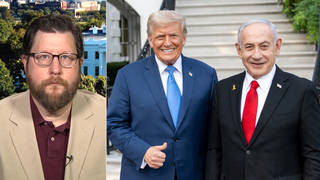
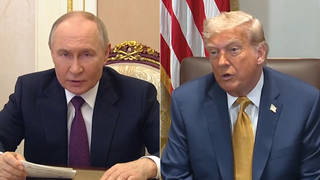
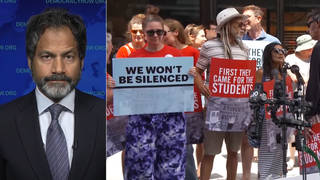
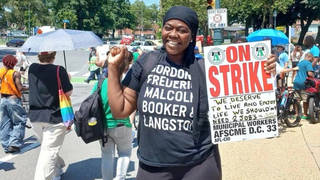
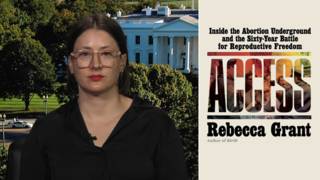
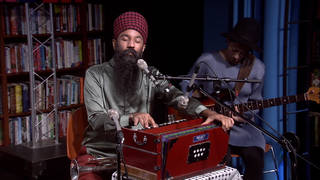
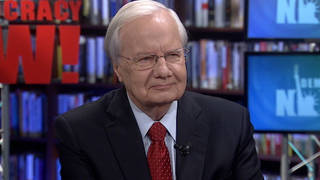
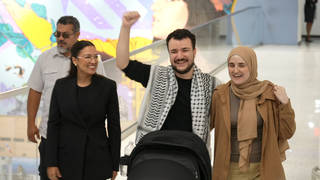



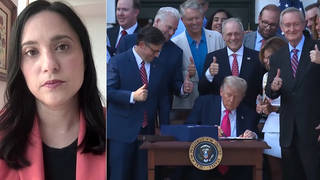
Media Options